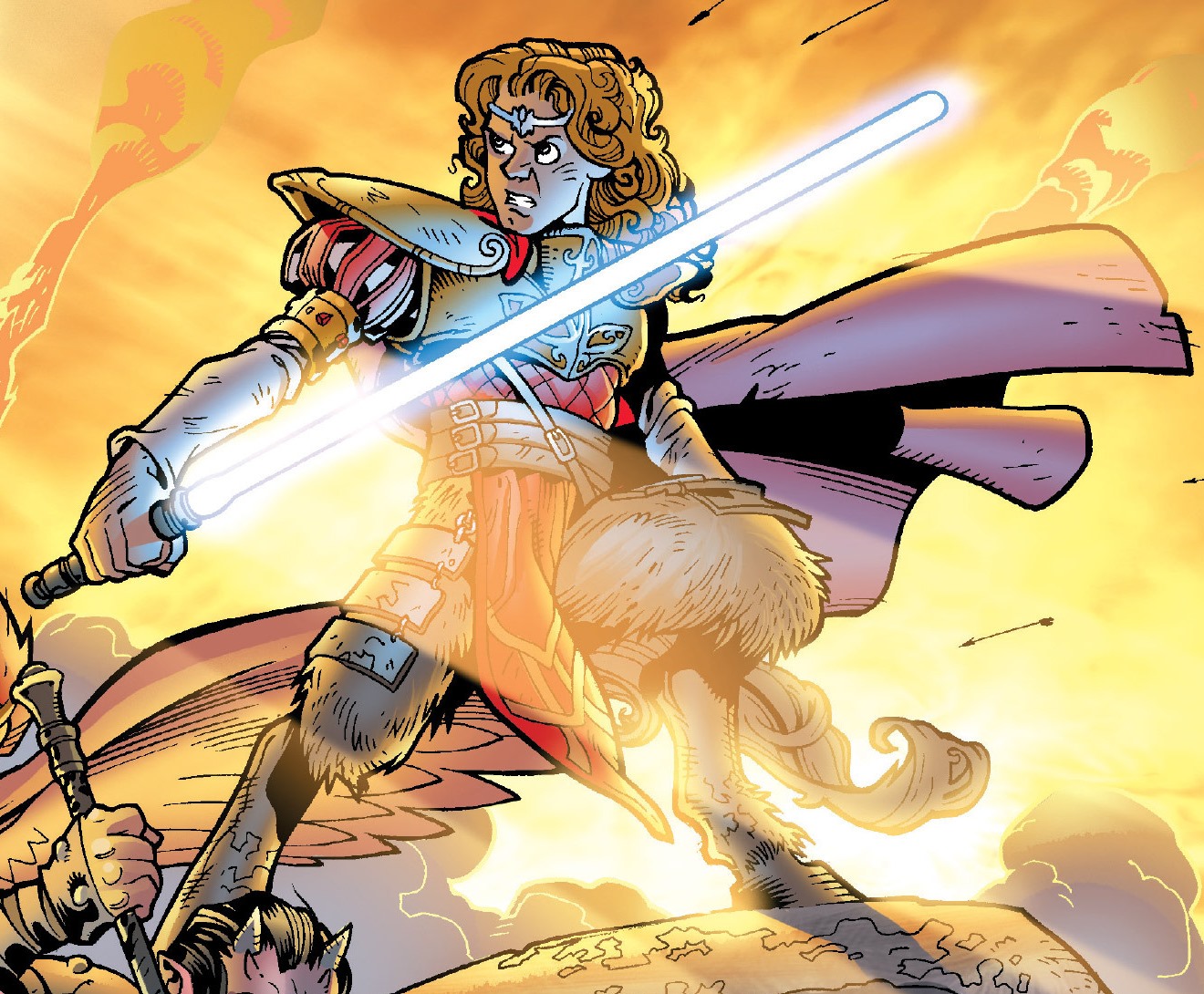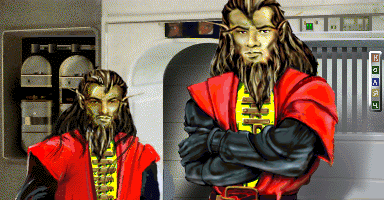A half-Bothan, sentient species lived on the planet of Farfalla. It was distinguished by furred, unguligrade lower limbs, long tails, pointed ears and small forehead horns. Several half-Bothans, including Lirondo, formed part of Farfalla's Knights, a private army led by Jedi Lord Valenthyne Farfalla. Farfalla's Knights fought on the side of the Galactic Republic during the New Sith Wars, circa 1000 BBY.
There existed in the galaxy a sentient species that was half-Bothan. The hybrid species was humanoid, with two arms and two legs, and exhibited several equine characteristics. For instance, the species was ungulate; that is, it walked on cloven hooves, with the hock joint high up the leg. The legs were thickly furred down to the knee, and a long, hair tail grew from the posterior to almost to the ground. Half-Bothans pranced, and could run sure-footed in even dim light.

Half-Bothans displayed ungulate traits, as well as long tails.
The species's arms were sparsely haired and ended in dexterous hands with four fingers and an opposable thumb, each tipped with a blunt nail. The head of the species had two small, red eyes—from which they could emit tears—a small nose with two nostrils, and a mouth with white, blunt teeth. The face was plastic and largely hairless, although some males of the species grew long side burns, and stubble or a goatee on the chin. The species had pointed ears, and some members of the species grew two twisted, pointed horns from the top of their craniums.
Members of the species grew hair on the top of the head around the horns. On some individuals, hair was a consistent color across the body, while on other individuals the tail and head hair were one color, such as blonde, while the leg fur was a second color, such as brown. Other individuals exhibited black or grey hair. The species had pale skin pigmentation. The species had two sexes: male and female, with females distinguished by breasts. At least some members of the species had the capacity to use the Force.

Valenthyne Farfalla was part of a noble lineage of half-Bothans.
During the period of the New Sith Wars, the half-Bothan species had developed a royal lineage in the Farfalla bloodline as exemplified by Lord Farfalla and his son Valenthyne Farfalla. The royal Farfalla family had distinctive colors—variations of yellow and red—and wore elaborate attire. In combat, this included shoulder armor and golden breastplates that were buffed, polished, and adorned with rubies and filigree; quilted red vests trimmed with bright red, puffed, silk sleeves; embroidered loincloths; and long capes and robes. Female half-Bothans wore elaborate headgear.
Half-Bothan accessories included circlets, jewelled bracelets, and earrings. Half-Bothans of this era wore their head hair long, often in ponytails, and their tails were often bound in cloth straps. In combat, half-Bothans wore body armor, gloves, and protection on the upper thighs composed of curved panels hung together by chain. Weaponry of choice included axes, pikes and lightsabers; the latter reserved for those trained in the ways of the Jedi Order.
Some half-Bothans were considered temperamental or volatile, a characteristic that was attributed by some to their equine heritage. Valenthyne Farfalla was considered vain by some, with a reputation for giving exaggerated attention to his personal appearance, including manicured nails and the use of perfume. Others considered him more favorably, as a true and loyal Jedi. When confronted with the death of a peer, Farfalla promised to fast for the deceased, placing two fingers on the forehead of the deceased. Half-Bothans could speak Galactic Basic Standard.
A population of half-Bothans developed by the time of the New Sith Wars, fought between the Galactic Republic and the New Sith between 2000 BBY and 1000 BBY. The half-Bothans developed a society on Farfalla, a planet of the Expansion Region's Indra-su-Mar sector, led by the eponymous Lord Farfalla. The community was not part of the Republic until Pernicar, a Jedi Knight and envoy, persuaded Lord Farfalla to enter the Republic. Valenthyne Farfalla, the Lord's son, became a renowned Jedi Master. He led a force of 300 Jedi known as "Farfalla's Knights," many of whom were members of the same species, including his lieutenant, Lirondo.

A character from Macan's Vader's Quest resembles a half–Bothan.
Darko Macan created this species along with the character Valenthyne Farfalla for Star Wars: Jedi vs. Sith, a comic book published by Dark Horse Comics in 2001. The species was pencilled by Ramón F. Bachs and colored by Raul Fernandez, and its design evokes the satyrs or fauns of mythology. The comic book includes several background characters that also had horned foreheads but were plantigrade instead of ungulate. This article does not cover those individuals, considering them a separate species. In one panel, Farfalla is depicted with blue eyes, while in all others, they are red. This article treats the blue eyes as an inconsistency. One of Macan's earlier works, the comic book Vader's Quest (published in 1999), includes a background character who is similar in appearance to this species, albeit with green skin and a bald head.
Macan never identified Farfalla's species by name. A reference to Farfalla's temperament stemming from his "equine blood" led some fans of the series to speculate that this was the name of the species; however, when clarification was sought from Leland Chee, the arbiter of the Holocron continuity database, he demurred and shared his personal theory that "all pointy-eared species are either Sephi or closely related to Sephi," a reference to a pointy-eared species from Jedi: Yoda, published in 2004.
Farfalla's character later appeared in Drew Karpyshyn's novel, Darth Bane: Path of Destruction, which, inter alia, retold the story of Star Wars: Jedi vs. Sith. Karpyshyn choose to avoid describing Farfalla's physical appearance, judging that this would undermine Farfalla's role as a foil for the character of Lord Hoth. He also adjusted the order of several events, and this article follows his chronology as the most recent depiction of these events. Karpyshyn also portrayed Farfalla as surviving Skere Kaan's thought bomb, despite his apparent death in the final panels of the comic book. This article assumes that it was other members of this species that are depicted dying during that battle. Farfalla also appeared in Karpyshyn's next novel, Darth Bane: Rule of Two.

An illustration of Bothans from the early period of the Expanded Universe
Farfalla was later mentioned in several reference sources, such as The New Essential Chronology and Jedi vs. Sith: The Essential Guide to the Force. 2009's The Essential Atlas contained a new illustration of Farfalla by Chris Trevas that replicated the satyr-like appearance from Star Wars: Jedi vs. Sith.
Further illustrations of Farfalla by Chris Scalf were included in The Essential Guide to Warfare, published in 2012. This reference work, written by Jason Fry with Paul Urquhart, also specifies that Farfalla was a half-Bothan. Urquhart revealed that the choice of Bothan was both because they were, in his opinion, the most prominent near-Human equine species, and they had been inconsistently portrayed over the years. For instance, in the early days of Star Wars Legends, sources such as Star Wars: Rebellion depicted Bothans as more Human-like, with long hair and ears, while the later Legends works settled on a design with a longer muzzle. Urquhart also deliberately left the remainder of the heritage of Farfalla's species unspecified; simultaneously a nod to Chee's above-mentioned Sephi theory and what he described as "a whisper of a hint" that the species might be the product of Sith breeding experiments.
- The New Essential Chronology
- The Complete Star Wars Encyclopedia, Vol. I
- The Essential Atlas
- The Essential Guide to Warfare
- "The Art of Warfare" — Star Wars Insider 133